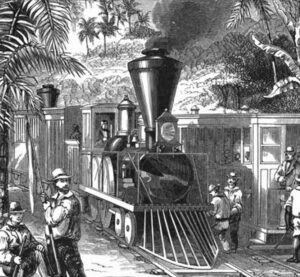
Because my overseas tour in the army was in the Republic of Panama, I was pleased to find a book, after I got home, called The Isthmus of Panama, and What I Saw There (1852), by Chauncey D. Griswold (no known relation).
Chauncey Griswold was a surgeon for the Panama Railroad Company, which broke ground in 1850 for the first transcontinental railroad, across the narrow isthmus. Construction was completed in 1855, 14 years before the US transcontinental railroad. As a result, the Panama Railroad was used by everyone from gold rushers to the US military in the Civil War. It became one of the great freight-moving lines of the world and was so profitable it was once the highest-priced stock on the New York Exchange. Later, the Canal was dug parallel to it, and Panama Railroad trains removed dirt and transported workers and materials. I rode the railway in the Noriega era.
No accurate count was ever made of nonwhite worker deaths during construction in the 1850s. The rumor has always been that a man died for every sleeper tie on the 48-mile route. David McCullough, in The Path Between the Seas, discounts this but estimates the toll at 6,000 to 12,000 workers. Most deaths were due to malaria, yellow fever, cholera, smallpox, and dysentery—“all the scourges against which there was no known protection or any known cure,” McCullough says.
The worst year was 1852, the year of Chauncey’s book, when cholera brought from New Orleans killed 48 of 50 American construction technicians, among others. Hundreds of soldiers from the 4th Infantry Division, along with their families, were transiting the isthmus, and 150 adults and children died. Ulysses S. Grant, their 30-year old commander, said, “The horrors of the road in the rainy season are beyond description.” That was also the year that John Lloyd Stephens, the President of the Panama Railroad, to whom Chauncey dedicated his book, died of malaria, probably contracted in Panama.
Chauncey says in his Preface that he has the explicit desire to write “a useful, rather than a pleasing book.” He has chapters on the Spanish in Panama, the buccaneers, the Scots, and (finally) the indigenous, as well as the flora, fauna, and agriculture of the isthmus. He discusses the proposed route for a ship canal and portrays his own impressions of travel.
But the two chapters that stand out as potentially most useful, given the catastrophic diseases, are those on “the insect tribes” (the last of which is the “musketoes”) and on “the climate of the isthmus [and] its influence on health.”
Early on, he talks about how when a mosquito gets through the bar, or net over your bed, “you resolve on his extermination, which being effected, you finally fall to sleep, thinking that, after all, man is sometimes exceedingly troubled with very little things.”
He does not understand how correct he is. As McCullough says, no one knew anything about the diseases they were exceedingly troubled with. Chauncey, as a medical doctor, still believed in the contemporary theory that miasmas, or foul airs, rose from the earth at night and caused disease. Germ theory did not gel until the 1880s, and viruses would not be discerned until the 1890s.
“Almost every one who visits the Isthmus to remain there any considerable length of time must expect, as a matter of course, to be more or less affected by the climate, yet not necessarily to have fever,” he says. “They will be predisposed to it by the miasma, but whether or not they will have it depend, oftentimes, upon an exciting cause.”
He is face-palmingly accurate on some details, to the point we could trade out “miasma” for “mosquito”:
“By observing proper precautions, a great deal may be done to avoid the miasma, which is the essential cause of the fevers. Miasma is eliminated while the surface is drying, after having been saturated by an overflow of the streams or previous rains; consequently, at such times the atmosphere contains more poison than any other. Another fact which has long been observed is, that the evening or night air is most of all pernicious, not so much because it is cool or damp, but from the unhealthy exhalations which hover near the earth like smoke of fog, during the night, more than at any other time.”
He gets it exactly right when he cautions against sleeping on the bottom floor of a dwelling and with windows open to fresh night air, without screens, but goes astray when he blames temperature changes and debauches for infectious illness.
But Chauncey got another thing right, too, which applies not only to his time’s mistaken theories but to today’s news:
“In a country like this, perhaps more than any other, where there are but few facts established in the popular mind with regard to health, every one voluntarily turns medical adviser; and I believe, as a general thing, the most ignorant are the most forward in their pretenses and options; and nothing can exceed the ridiculous authority often exhibited by such parties upon this grave subject, with no better authority for the support of their views, than that they ‘believe so,’ and that is sufficient.”
